

Digital Memories
>Back Issues
Special Collections at the University of Idaho Library offers a changing
showcase of highlights from our collections. Here are the entries for 1999:
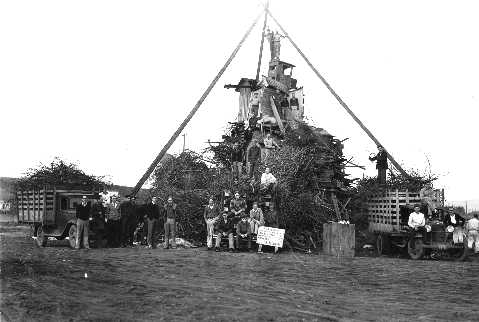
Football fever and school spirit were as much a feature of university life seventy years ago as they are today. Rallies, contests, and bonfires added to the spectacle. The big event, of course, was the then annual game with Idaho's cross-border rival.
Reminiscences and photographs in the library's collections recall that sense of excitement. Among these is Martin Larson's novel Plaster Saint (1953). This novel recalls the author's two years, 1925-1927, as Assistant Professor in the English Department at the University of Idaho. Included is the excitement and drama of the big pep bonfire on the eve of the big game with the nearby state university. It is possible to read Moscow as the town he describes as Belle Ridge in this excerpt:
On this Friday night the great annual bonfire would take place on the slope just east of the Engineering Building. Half the men in the university were engaged in preparing this enterprise. They searched every nook and corner of Belle Ridge for lumber, boards, sticks, tarpaper, corrugated boxes, stumps, logs, coal, oil, gasoline, kerosene - anything, everything, that would make a tremendous blaze. Wagons, carts, automobiles, trucks - every type of conveyance - had been used to transport the fuel. But the pyre would not be constructed until almost the last minute, because no greater victory was conceivable - except winning the great game itself - than that of setting fire prematurely to an opponent's pyre.
Every imaginable sort of stratagem was used to accomplish this purpose. Last year the university had attempted to fire State's pile from an airplane, which dropped flaming torches just before the celebration was to begin. Two years before, a very energetic young man who had been working all day with the students in Belle Ridge, gathering logs, suddenly turned out to be an enemy, who lunged at the pile as it was nearing completion and threw gasoline upon it. As he almost succeeded in firing it, he was pounced upon and severely beaten. This had been a close call.
The novel also offers a very personal view of the university seen through the prism of unhappy recollection. Filled with Jazz Age chicanery, embezzlement, adultery, failed idealism, and the triumph of evil over naivete, Plaster Saint offers a not very attractive picture of the university's inhabitants and habitues.
Is it autobiographical, a reminiscence of a real experience in Moscow? There are many parallels between the novel and the University of Idaho in the 1920s. Not the least is that Larson left teaching to return to Michigan where he sold insurance for several years before opening a paint store. Many of the libertarian ideas his hero espouses in the book are reflected in his service to Americans United for Separation of Church and State in the mid 1960s. He died in Phoenix, Arizona, in 1994, author of a number of political and philosophical works, and one novel.
Caption: University of Idaho freshman bonfire. 1931. Photo by Hodgins. Historical Photograph Collection, University
of Idaho Library. #2-102-7c.
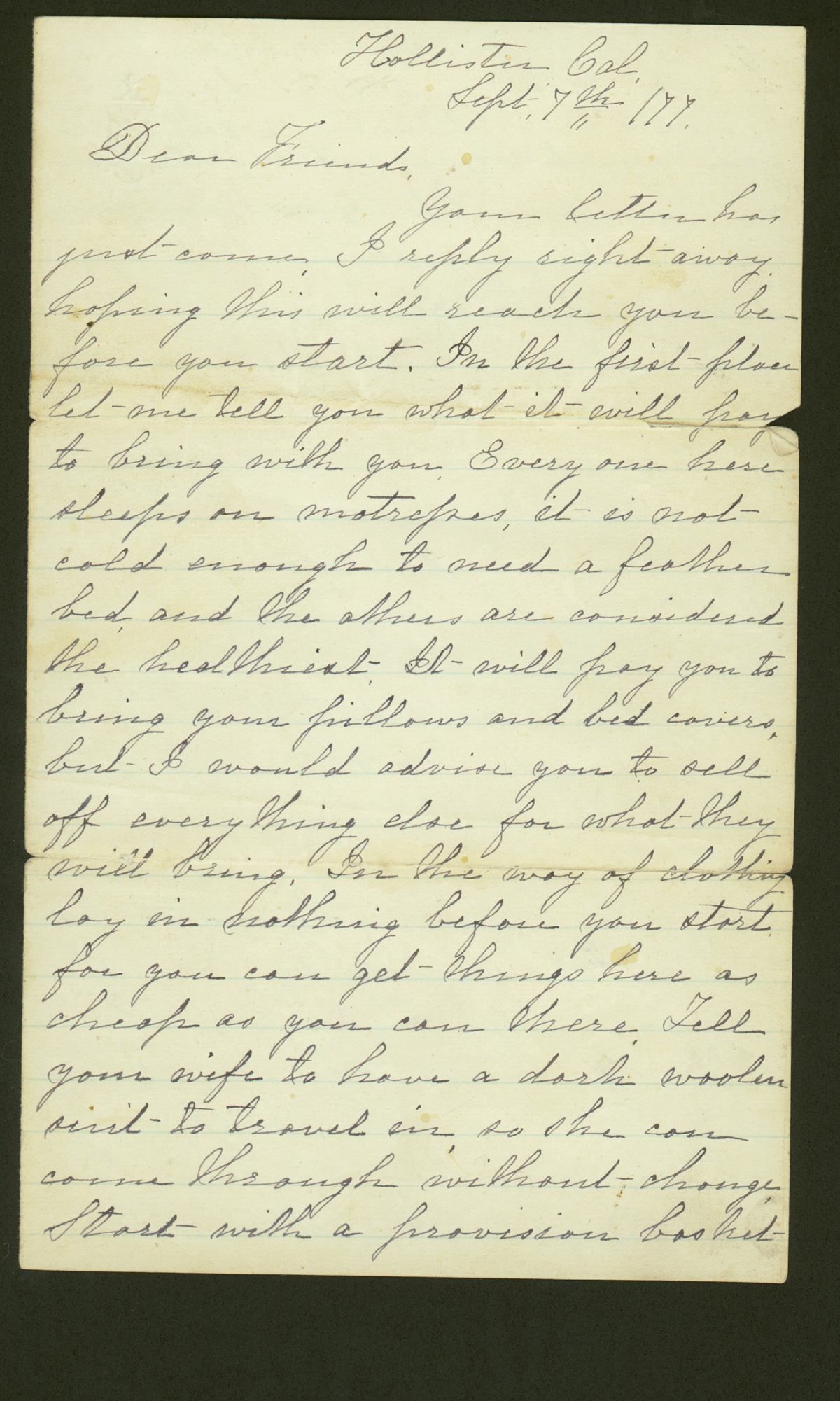
Hollister, Cal
Sept 7th '77
Dear Friends,
Your letter has just come. I reply right away hoping this will
reach you before you start. In the first place let me tell you what it will pay to bring
with you. Every one here sleeps on mattresses, it is not cold enough to need a
feather bed, and the others are considered the healthiest. It will pay you to bring
your pillows and bed covers, but I would advise you to sell off everything else for
what they will bring.
In the way of clothing lay in clothing before you start for you
can get things here as cheap as you can there. Tell your wife to have a dark
woolen suit to travel in, so she can come through without change.
Start with a provision basket with enough in it to do you two
days anyway, and don't forget to put in a tin-cup or small coffee pot and ground
coffee and sugar. You can then save lots by making your coffee on the car
stoves.
Put up soap and towels, or you will suffer from the dust,
Have a strap and buckle to put up a pillow and blanket or shawl for each of you,
and unless the cars are crowded you can come all the way without the expense
of a sleeping car.
You may be crowded till after you reach Omaha but after
that you will have plenty of room. We got through tickets at Chattanooga to San
Francisco by way of Grand Junction, Miss, Cairo, Ill, St. Louis, Council Bluffs and
Omaha. They will only check your baggage to Omaha. There get it rechecked
to San Jose, Cal. Have it put up very securely, or it will be smashed certain.
Put a little wash-pan and tin cup to drink out of in your basket
and have as little loose baggage as possible, for you often have to change
cars in a hurry.
From Omaha to Ogden, three days travel, you don't change
cars. At Ogden, you can lay in provisions right at the depot for the rest of the way,
two days.
When you get to Niles Station, nearly at San Francisco, change
cars for San Jose where you will have to stay all night. It costs less than in San
Francisco and is right on the road to Hollister. Stop at the New York Exchange
Hotel, it is the best and cheapest.
From there, get tickets and checks for Hollister, 40 miles.
You have to change cars at Gilroy and will get here at 2 o'clock in the evening.
This is said to be the cheapest and best route. My ticket from Chattanooga cost
$136.00 to Niles, $5.00 from there here.
If you want to come by emigrant train you will take it at Omaha.
I did not try it, it is so slow. Gold or silver is used here but you can exchange your
greenbacks at the banks here as well as you can there. You will have to look out
for your money for a set of smooth-faced roughs frequent the cars.
Mrs. McCroskey and I got here without being the least tired.
We tried the sleeping car once, but did not like it. It cost us $2.00 apiece each night
and we were glad to get out of...
Travel to the west was made easier with the completion of the transcontinental
railway but it was still enough of an adventure to benefit from guides from friends
who have gone before. J.H. McCallie was Moscow's first dentist, arriving here in 1878. His daughter
Margaret attended the University of Idaho and graduated in 1898. Between
1899 and 1905 she served as the University's librarian. Before her death
in 1972, she donated this letter, and other materials, to the University
of Idaho Library.
This letter illustrates the common tendency of primary sources to locate themselves
in archives which scholars can only find through painstaking research in unlikely places. In this case,
the letter was written in California as advice to an prospective emigrant in Tennessee who
carried it west in his well-secured baggage. And further, he carried it with him from California
to Idaho; where, years later, his daughter in Spokane donated it to her alma mater. In such ways, are manuscripts materials located in what is clearly the perfectly logical repository;
yet so difficult to anticipate. Only after all the relationships are known is it possible to discern
the logic of its eventual resting place.
Letter fragment, from a McCroskey to J.H. McCallie, September 7,
1877, describing provisions needed for train journey from Tennessee to
California. Part of the Margaret McCallie Moore Papers, MG5159, University
of Idaho Library.
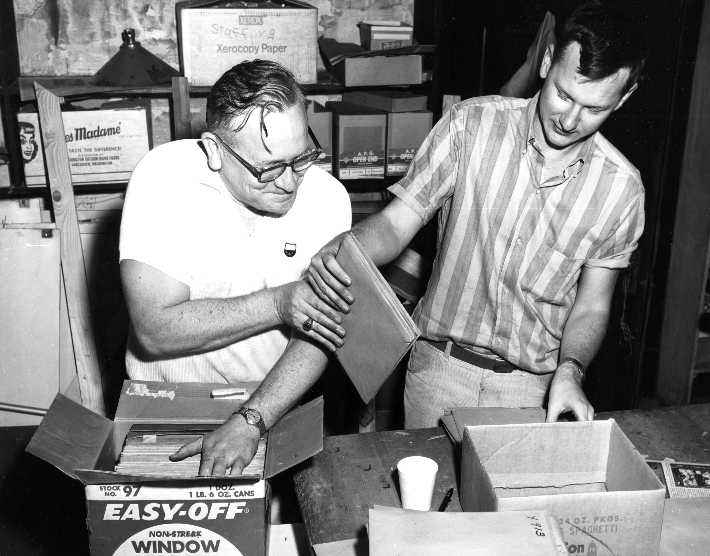
Neatly stacked on shelves, or presented to researchers in well organized
containers, archival collections in repositories conceal a past that is
frequently gritty and disarrayed. The effort of producing an inventoried,
reboxed, properly labeled body of primary source material is hidden from
the researcher by the antiseptic neatness of its presentation in the reading
room.
While inventories may suggest that processing the material occupied
months (or even years) of staff time, even that statement glosses over
the sheer physical labor of moving boxes from where they might have been
stored (be that basement, attic, barn, or shed) to the library or archives.
Nor is the subsequent shelving of the accessioned materials, their transport
to the workroom for processing, a three stage pass for processing, reboxing
and reshelving. A thirty-five pound box quickly (or more likely slowly)
becomes 280 pounds when moved several times.
Documenting this effort in more than vague generalities is seldom undertaken.
A photograph of the process is not a necessary part of the mechanics of
acquiring, arranging, and describing primary source material. In this photograph
we catch a glimpse of the early stages in the process. Here, Special Collections
Librarian Charles A. Webbert, assisted by Librarian Paul Conditt, pack
the first shipment of an estimated 100,000 glass and film negatives produced
by the Barnard Studio of Wallace, Idaho over a ninety year period. The
darkness, dust, and claustrophobic closeness of the space is, however,
only hinted at; making this less a true picture of the experience and more
another example of the effort to keep hidden the essential physicalness
of the work of guarding and preserving Idaho's heritage.
Caption: Librarians Charles Webbert and Paul Conditt pack the
Barnard Studio glass negatives in a Wallace basement for transport to the
University of Idaho Library, 1965. Photograph by Glenn E. Sprouse. Historic
Photograph Collection, University of Idaho Library. #1-400-08.
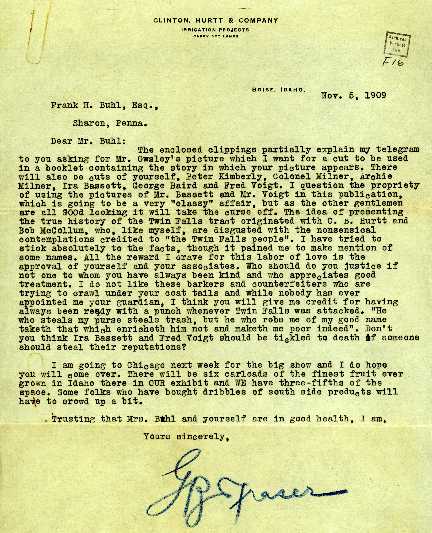
That the roiling waters of the Snake River were "tamed" and transported
over the canyon walls to water the sagebrush desert of Southern Idaho owes
much to eastern financial resources exemplified by industrialist Frank
Henry Buhl. Born in 1848, Buhl made his fortune as a steel mill owner in
Pennsylvania, selling out to the expanding U.S. Steel in 1902. Soon after
he was approached by banker Stanley B. Milner of Salt Lake City with a
western land development proposition. Milner had placer mining claims on
the Snake River and was thus receptive to Ira B. Perrine's idea, based
on irrigation engineer A.D. Foote's studies, to dam the river above the
Twin Falls and shunt the water out to irrigate the surrounding lands.
Milner persuaded Buhl and his associate Peter Kimberly to invest in
the project, and Buhl became president of the Twin Falls Land and Water
Company. Using their contacts to bring in European investors and $3.5 million,
the 244,000 acre Twin Falls Project became one of the country's first large
irrigated land reclamation projects, and a Carey Act success story.
George Fraser was a publicist for Boise's Clinton, Hurtt & Company
which managed the real estate sales for the irrigated tract. He was also
editor of the Twin Falls News, which magnified his community booster
role. In this letter, Fraser refers to the efforts of others to capitalize
on the success of the Twin Falls project and seeks Buhl's help in publicizing
his own efforts.
Although Clinton, Hurtt published an illustrated booklet -- The Lure
of the Land -- promoting their operations in late 1909, the only portraits
are those of company employees. It does say that George Fraser is "a close
student of human nature, an observer with a practical turn of mind" and
that he is "thoroughly conversant with conditions and how they were brought
about, and is one of the best posted men on irrigation development in the
West."
Fraser's letter, plus some Boise newspaper clippings, all separated
from Buhl's files (he died in 1918), were donated to the University of
Idaho
Library in 1953.
Letter: G.B. Fraser, Boise, to Frank H. Buhl, Sharon,
PA, November 5, 1909. MG 5001. Special Collections and Archives, University
of Idaho Library.
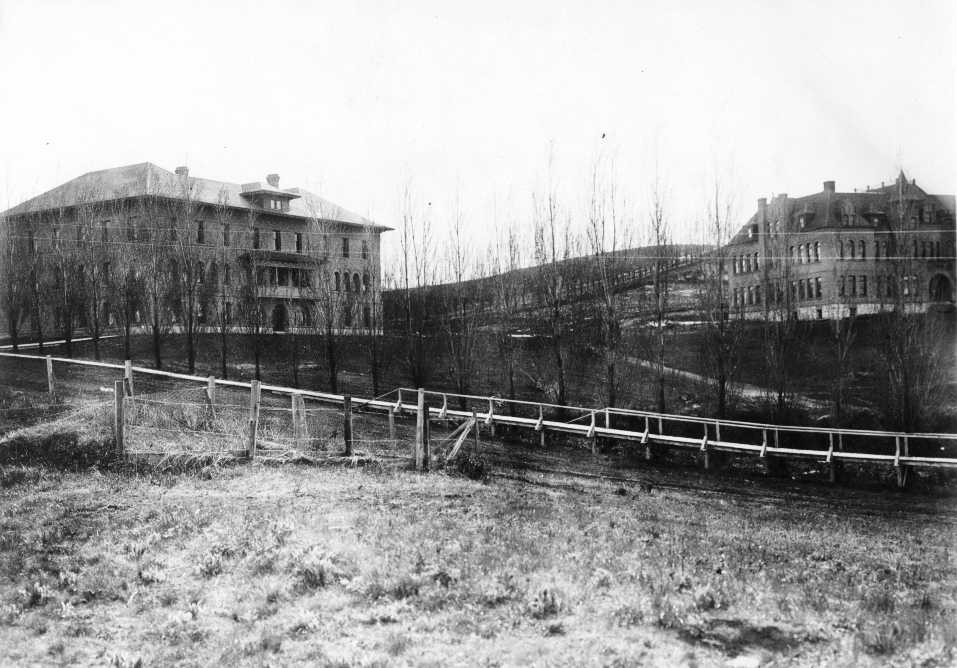
Through the ring of poplars that once surrounded the campus stands Ridenbaugh
Hall in this image. Though the poplars are long since gone, Ridenbaugh still stands today.
Although the building has fostered many uses, presently music rooms and
an art gallery, it was originally constructed as a girls' dormitory. It
is the oldest remaining building on the University of Idaho campus, erected
in 1902, and is listed on the National Register of Historic Places. Mary
Ridenbaugh, then vice president of the Board of Regents for the school,
was honored at the building's dedication, recognizing her commitment to
the school and the young women of the University of Idaho.
An appreciation of this addition is evident in the 1903 Gem of the
Mountains, the University of Idaho yearbook, where this description
of the building appeared:
Just a little further east of the School of Mines is situated
the Girls' Dormitory, known as Ridenbaugh Hall. This too is a three story
brick building, and presents a very comfortable appearance in the cosy
corner of the campus. The interior is a network of rooms which are artistically
arranged to meet the requirements of beauty, comfort, and economy. It is
capable of accomodating 75 ladies. The want of proper care for the young
ladies from surrounding cities and towns has long been a hinderance to
the development of the institution, but this want has been obviated, for
with this elegant building in the hands of such competent women as Mrs.
Young, Preceptress, and Mrs. Henderson as Matron, the young ladies of our
state have at their disposal an ideal home.
An amazing woman in her own right, Mrs. William H. Ridenbaugh was active
in politics, education, and social circles. She served on the Board of
Regents at the University of Idaho for three terms. One of the most prominent
women of her day, Mary Ridenbaugh was well read and well traveled, viewed
as a gracious and entertaining hostess. With her grace and persistence,
she played an integral part in the formation of Idaho's dormitory and Domestic
Science program, two significant steps for the education of women at the
University of Idaho.
Idaho's Department of Domestic Science was established the same year
Ridenbaugh Hall was completed. The University of Idaho was the first institution
in the Pacific Northwest to adopt such a program. In the 12'x12' kitchen
at Ridenbaugh Hall, the first domestic science cooking classes began, and
they remained there until a wing of the new Administration Building was
designated for their use.
Photograph selected, and text written, by University of Idaho student,
Kerry Brent.
Caption: Ridenbaugh Hall (on left). 1902. Historical Photograph
Collection, University of Idaho Library. #1-58-17.
|
[U of I Library] [Catalog Search] [U of Idaho]
|
|
Special Collections & Archives University of Idaho Library PO Box 442351 Moscow, Idaho 83844-2351 USA (208) 885-7951
|
|
© Copyright 2002 University of Idaho Library
|






